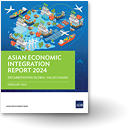To Reach Net Zero, Trade Must Be a Climate Solution For Asia and the Pacific
These charts illustrate Asia and the Pacific’s growing role in production and trade, which are key drivers of climate change-related emissions. To reach net zero, Asian countries need to take action immediately.
Countries in Asia and the Pacific play critical roles in the battle against climate change. They generate about half of global greenhouse gases annually and are highly vulnerable to climate risks. Failure to tackle climate change would cost the region a staggering $210 trillion in economic losses until the end of the century, with developing countries in Asia losing 24% of their gross domestic product (GDP), according to ADB estimates.
Decisive policy actions are needed now, with no less than the future of the region and the world at stake.
With Asia’s rapid industrialization and central role in global value chains, carbon dioxide emissions embodied in production and consumption increased almost threefold from 1995 to 2018, with growth in production-based emissions expanding faster than those attributable to consumption.
Trade and trade policy can play a vital role in the transition to net zero. Economies in Asia and the Pacific are among the most open in the world. For example, Asia and the Pacific accounted for 37% of world trade in 2021, up from 32% a decade earlier. Trade in goods accounts for almost 100% of GDP in the Association of Southeast Asian Nations (ASEAN) economies.
Emissions embodied in Asian manufactured exports account for three-fourths of the total, followed by transportation and other services.
Globally, exports account for about 30% of total production-based CO2 emissions, significantly up from 1995. The share of exports in total production-based emissions for Asia grew even faster than the world average, especially between 2001 and the financial crisis, and rose over one-third from about 23% to 31% from 1995 to 2018.
By subregion, East Asia’s emissions embodied in exports rose the most in the share of global total, from 18% in 1995 to 30% in 2018. During the same period, Southeast Asia and South Asia also saw increases in their global share by 3.6 percentage points and 3.3 percentage points, respectively.
Intraregional trade makes a significant contribution to Asia’s carbon footprint, given the deepening of regional value chains. Two-thirds of emissions embodied in Asian imports are from intraregional sources and half of its exports are for intraregional destinations.
These trends underscore the key potential role of trade-related actions in moving the region toward net zero emissions. Trade offers many solutions via facilitating exchange of environmental goods and services, technology transfer, and investment in green sectors and low-carbon technologies. Initiatives like the Regional Comprehensive Economic Partnership and greening regional value chains can help reduce Asia’s carbon footprints if properly designed and implemented.
The important nexus between trade and climate change suggests vast opportunities facing the region to accelerate net zero transition if trade and trade policy tools can be deployed together to support inclusive growth and green transition in Asia and the Pacific. The following actions should be taken immediately.
Mainstream trade and trade policy into nationally determined contributions. More explicit and stronger inclusion of trade-related actions should be reflected in nationally determined contributions to make the transition to net zero smooth and just.
Reduce tariffs and trade restrictions on environmental goods and services. Promote the allocation of resources to more carbon-efficient production and investment. Tariff reductions together with increasing environmental awareness and regulations also help change consumption patterns in favor of environmentally friendly goods and services.
Boost technology transfer. Trade measures such as tariffs and environmental provisions in trade and investment agreements can support the transfer of greener technologies and technology spillovers to developing countries.
Accelerate trade facilitation and logistics reforms. Reduce delays at borders and remove bottlenecks along the supply chain. Implementation of cross-border paperless trade has strong potential to reduce carbon emissions and environmental burdens.
Work together to develop more efficient and effective policy frameworks for the region. Leverage the trade and climate nexus, promoting green finance and investment, and find equitable solutions along the pathways to net zero. Cooperation is a must to scale up technical assistance and capacity building on carbon measurement techniques and traceability.
Asia and the Pacific, which as a region is responsible for a large proportion of global greenhouse gas emissions and highly vulnerable to its impacts, faces huge economic and humanitarian losses if countries do not take urgent and decisive policy actions to embrace cleaner and greener trade.
This blog post is based on research done for the publication The Role of Trade in Asia and the Pacific’s Net Zero Pathways: Overview and Policy Implications
Original article was published at the Asian Development Blog and duplicated here with permission from the author. *



